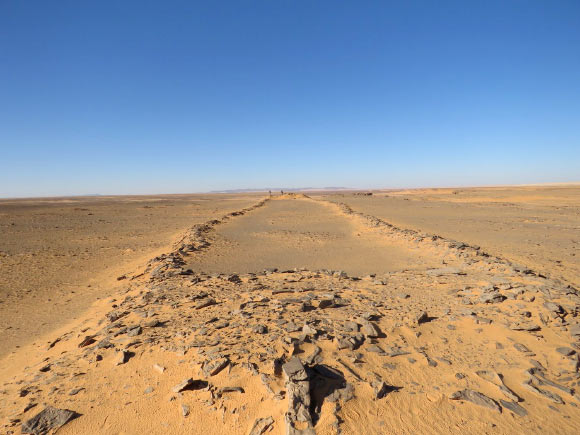An international team of archaeologists has found and studied 104 enigmatic stone structures called ‘mustatils’ in the southern part of the Nefud Desert in northern Arabia. They’ve also provided the first chronometric age estimate for this type of structure — a radiocarbon date of 5000 BCE — and described their landscape positions, architecture and associated culture.
Source: Sci News
“Between 10,000 and 6,000 years ago the Arabian Peninsula saw the most recent of the ‘Green Arabia’ periods, when increased rainfall transformed this generally arid region,” said lead author Dr. Huw Groucutt from the Max Planck Institutes for Chemical Ecology, the Science of Human History, and Biogeochemistry and colleagues from Germany, the UK, Australia and Saudi Arabia.
“The transition to the Neolithic in Arabia occurred during this period of climatic amelioration.”
“Various forms of stone structures are abundant in northern Arabia, and it has been speculated that some of these dated to the Neolithic, but there has been little research on their character and chronology.”
Dr. Groucutt and co-authors carried out detailed inspection of high-resolution satellite data to identify the distribution of mustatils in the southern Nefud Desert, between the cities of Ha’il and Tayma.
They identified a total of 104 mustatils and found that these structures typically consist of two large platforms, connected by parallel long walls, sometimes extending over 600 m (1,969 feet) in length.
“The mustatils of the southern Nefud Desert are relatively homogenous,” they said.
“They are elongated rectangles, with 102 out of 104 examples having two long walls, and the other two having three.”
“One of the examples with three walls is also the only clear example where the distal platforms extend outwards further than the point at which the long connecting walls join the platform.”
At one site, the scientists found an assemblage of animal bones, which included both wild animals and possibly domestic cattle or wild auroch.
They also recovered a piece of charcoal from a section inside the platform and dated it to around 7,000 years ago.
“The function of mustatils remains enigmatic, though based on our combined satellite and field findings, some possibilities can be highlighted and explored by future research,” they said.
“A number of features evident on the ground, and not visible on satellite imagery, furnish crucial information on mustatils.”
“For instance, the long walls are very low and typically lack obvious entry points, and therefore do not seem to be obviously functional as something like animal corrals.”
“Likewise, the morphology and landscape position of these structures argue against other ‘pragmatic’ possibilities such as water storage.”
“While mustatils are often located near prominent landscape features such as lakes and sandstone jebels, they do not seem to emphasise being highly visible in the landscape, in contrast to many (but not all) later structures, such as different forms of cairns/tombs.”
“What becomes clear on the ground is that structures are primarily defined in structural terms by large stone platforms at either end, with the low walls between them denoting a perhaps conceptually, rather than effectively, enclosed space.”
The team also discovered a painted rock on the interior face of one of the mustatils.
This painted, and faced, slab shows that the interior face of the platforms was sometimes decorated, indicating a consideration of the presence of viewers who were inside the space created by the platforms and the walls.
“Our interpretation of mustatils is that they are ritual sites, where groups of people met to perform some kind of currently unknown social activities,” Dr. Groucutt said.
“Perhaps they were sites of animal sacrifices, or feasts.”
“The fact that sometimes several of the structures were built right next to each other may suggest that the very act of their construction was a kind of social bonding exercise.”
The research is described in a paper published in The Holocene.
Source: Sci News

































Leave a Comment
You must be logged in to post a comment.